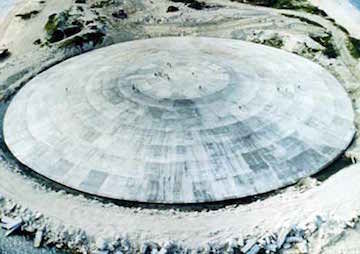Scientists Warn Giant Nuclear Sarcophagus in Marshall Islands Is Leaking
One hundred and eleven thousand cubic yards of radioactive debris lies within Runit Dome, a “hulking legacy of years of U.S. nuclear testing” whose fragile structure is vulnerable to breaking from violent weather associated with climate change.
Runit Dome was built to store radioactive soil scraped from the various contaminated Enewetak Atoll islands. (U.S. Defense Special Weapons Agency)
One hundred and eleven thousand cubic yards of radioactive debris lies within Runit Dome in the Marshall Islands, a “hulking legacy of years of U.S. nuclear testing” whose fragile structure is vulnerable to breaking from violent weather associated with climate change.
“Runit Dome represents a tragic confluence of nuclear testing and climate change,” Michael Gerrard, director of the Sabin Center for Climate Change Law at Columbia University, who visited the dome in 2010, told The Guardian.
Now locals, scientists and environmental activists fear that a storm surge, typhoon or other cataclysmic event brought on by climate change could tear the concrete mantel wide open, releasing its contents into the Pacific Ocean. …
In total, 67 nuclear and atmospheric bombs were detonated on Enewetak and Bikini between 1946 and 1958 – an explosive yield equivalent to 1.6 Hiroshima bombs detonated every day over the course of 12 years.
The detonations blanketed the islands with irradiated debris, including Plutonium-239, the fissile isotope used in nuclear warheads, which has a half-life of 24,000 years.
When the testing came to an end, the US Defence Nuclear Agency (DNA – later the DoE) carried out an eight-year cleanup, but Congress refused to fund a comprehensive decontamination programme to make the entire atoll fit for human settlement again.
Read more here.
— Posted by Alexander Reed Kelly.
Independent journalism is under threat and overshadowed by heavily funded mainstream media.
You can help level the playing field. Become a member.
Your tax-deductible contribution keeps us digging beneath the headlines to give you thought-provoking, investigative reporting and analysis that unearths what's really happening- without compromise.
Give today to support our courageous, independent journalists.






You need to be a supporter to comment.
There are currently no responses to this article.
Be the first to respond.